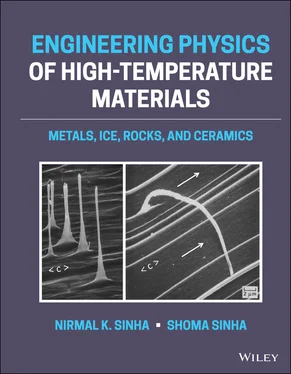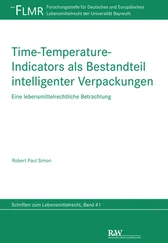Nirmal K. Sinha - Engineering Physics of High-Temperature Materials
Здесь есть возможность читать онлайн «Nirmal K. Sinha - Engineering Physics of High-Temperature Materials» — ознакомительный отрывок электронной книги совершенно бесплатно, а после прочтения отрывка купить полную версию. В некоторых случаях можно слушать аудио, скачать через торрент в формате fb2 и присутствует краткое содержание. Жанр: unrecognised, на английском языке. Описание произведения, (предисловие) а так же отзывы посетителей доступны на портале библиотеки ЛибКат.
- Название:Engineering Physics of High-Temperature Materials
- Автор:
- Жанр:
- Год:неизвестен
- ISBN:нет данных
- Рейтинг книги:3 / 5. Голосов: 1
-
Избранное:Добавить в избранное
- Отзывы:
-
Ваша оценка:
- 60
- 1
- 2
- 3
- 4
- 5
Engineering Physics of High-Temperature Materials: краткое содержание, описание и аннотация
Предлагаем к чтению аннотацию, описание, краткое содержание или предисловие (зависит от того, что написал сам автор книги «Engineering Physics of High-Temperature Materials»). Если вы не нашли необходимую информацию о книге — напишите в комментариях, мы постараемся отыскать её.
Discover a comprehensive exploration of high temperature materials written by leading materials scientists Engineering Physics of High-Temperature Materials: Metals, Ice, Rocks, and Ceramics
Engineering Physics of High-Temperature Materials (EPHTM)
Engineering Physics of High-Temperature Materials
Engineering Physics of High-Temperature Materials: Metals, Ice, Rocks, and Ceramics
Engineering Physics of High-Temperature Materials — читать онлайн ознакомительный отрывок
Ниже представлен текст книги, разбитый по страницам. Система сохранения места последней прочитанной страницы, позволяет с удобством читать онлайн бесплатно книгу «Engineering Physics of High-Temperature Materials», без необходимости каждый раз заново искать на чём Вы остановились. Поставьте закладку, и сможете в любой момент перейти на страницу, на которой закончили чтение.
Интервал:
Закладка:
1.6.2 Elastic, Delayed Elastic, and Viscous Deformation
Mechanically or thermodynamically induced stress deforms a material from its original shape. Stress‐induced deformation in a material, whether it is stated clearly or not, is historically assumed to be divided into two major parts – an elastic part and an inelastic part. Instantaneously occurring deformation of the lattice structure on the rapid application of a load or instantaneously recoverable deformation on the rapid removal of a load is known as an elastic response. Perhaps the latter description is more appropriate, because inelastic deformation may occur during loading, but any inelastic deformation is “not expected” to recover on unloading. The use of the words “not expected” is associated with the idea that it is rather complicated and sounds vague. This is because the term “inelastic” in the multidisciplinary field of classical engineering, as mentioned earlier, is associated with part of the deformation that is “really a deviation” from the elastic behavior.
Trinity of Strain
ELASTIC
DELAYED ELASTIC
VISCOUS
It is recognized that inelastic or permanent viscous deformation is always accompanied by small, but recognized, elastic deformation. But, what about the strain component that is elastic, but develops with time and is recoverable on unloading? Naturally, the preferred term for this is “delayed elastic.”
The use of the term “delayed elasticity,” as an integral part of the field of rheology, needs some explanations. Briefly, the term “rheology” was defined as “the science of the deformation and flow of matter” at the inaugural meeting of the (American) Society of Rheology in Washington, DC, in 1929. Rheology is a broad field, and consequently different technical terms are used for the same or similar experimental observations. The rheological terms adopted by the British Standards Institution (BSI 1975) are used in this book. The term “anelasticity,” although popular in the field of metallic materials and rock mechanics, will be avoided. In Section 6.2 of Chapter 6, we have clarified this in detail.
The delayed response is not given importance in mechanics unless seismic frequencies or short‐term loadings are involved. It is also not universally recognized (rather ignored) unless high temperatures are involved, that inelastic deformation is always time dependent, and that “time” could be very short, but indeed sufficiently long to stretch the lattice bonds between the constituent atoms, as well as moving the lattice defects (point and line). Time dependency arises because inelastic deformation involves the movement of lattice defects within the solid material. Perhaps because of this nonrecognition, inelastic deformation is often called “plastic” deformation, when the time dependency involved is not obvious, and “creep” when time becomes a major factor. The concept of time‐independent plasticity and its broad application in many engineering fields simply ignores the physics of materials science. Since time‐dependent deformation is readily observed at high temperatures, creep is always, or readily, associated with high temperatures. This leads to the widespread misconception that creep is a high‐temperature phenomenon. The often not recognized fact is that creep can also occur at low temperatures. Sagging in glass windows of old buildings is an example. It has been seen that windows reveal measurable differences in their thickness between thinner upper and thicker lower parts. Of course, early manufacturing of glass sheets using rollers was also not optimized and the installer of the plate would naturally choose the thicker end for the bottom. Sagging in steel beams due to creep, beyond elastic response, with age in buildings is also commonly seen. Short‐term creep can occur in certain modern metals and alloys at low temperatures as well, for example, in aerospace materials, like titanium‐base alloys at room temperature (Wapniarsky et al. 1991).
Historically systematic studies on “creep and recovery” aspects of engineered materials at elevated temperatures became popular since the publication of Andrade (1910) on steel (see Chapter 6on fundamentals of high‐temperature deformation). During the last hundred years, the phenomenological and micromechanical aspects of creep and failure properties obtained from simple isothermal constant‐load (CL) “creep and creep‐rupture tests” drew the attention of most materials scientists. Creep tests at a constant temperature are performed by applying a load as quickly as possible, using a dead‐load system, and the increase in strain with time is monitored while maintaining the load constant. As mentioned earlier, several books have been published on high‐temperature creep and failure of materials, but these books mostly covered progress made primarily on metallic materials. Many crucial aspects of the “physics of creep,” however, have remained unanswered and vigorous attempts are being continued in materials science laboratories all over the world. As mentioned earlier, Holdsworth et al. (2005) have provided an up‐to‐date list of wide‐ranging creep model equations being used today for ascertaining high‐temperature rheological properties of engineering materials. Most of these equations are based on classical empirically derived representation of primary, secondary, and/or tertiary creep deformation in pure metals and alloys as functions of stress, time, and temperature. Creep responses of single‐crystal and polycrystalline alloys used at high temperatures have been covered. Surprisingly, none of the empirically based models address the grain‐size effects of transient, secondary, or tertiary creep. Moreover, none address microstructure‐dependent, experimentally verifiable, delayed elastic phenomena in engineering materials.
Creep Trinity
PRIMARY
SECONDARY (steady state)
TERTIARY
Evans and Wilshire (1985, p. 72) eloquently pointed out that the now standard terminology of primary, secondary, and tertiary creep, the main features of normal creep curve in metals, originated in Andrade's work on steel. We will call this the “creep trinity.”
Creep curves for polycrystalline materials (also ordinary glass) drawn between axial strain and time for a constant load typically (called normal) consist of three stages: a decelerating primary or transient stage, a secondary or steady‐state stage, and an accelerating tertiary stage.
Experimentally, it is simpler to concentrate on the secondary creep during which the strain rate does not vary with time and tends to a minimum value. The minimum creep rate is thus subjected to minimal error of measurement. Constitutive equations for high‐temperature deformation of metals, alloys, rocks, and ceramics are thus largely based on the concept of “steady‐state” conditions. Tertiary or accelerating stages were associated with damage‐enhanced creep and were of no interests until the aeroengine usage of nickel‐base single‐crystal superalloys in gas turbine engines became a reality (see Chapter 5for details). Tertiary creep under constant tensile load in nickel‐base single‐crystal superalloys has been shown to represent a “dynamic steady state” for the dependence of engineering strain rate on the corresponding actual or true stress (Sinha 2006).
For temperatures less than 0.3 T m, time‐dependent deformation is characterized by asymptotically decreasing creep rate, known as logarithmic creep. At elevated temperatures, higher than 0.4 T m, trinity aspects of creep are readily noticeable, but the shape of the primary creep in polycrystalline materials varies on the texture and structure of the material. Primary creep is called “normal” when it exhibits decelerating creep rate with time. Steady‐state or secondary creep rate is quantified experimentally from the measurements of minimum creep rate (mcr). It takes a long time to reach steady state for stresses less than about 1 × 10 −5E (where E is the Young's modulus) known to initiate microcracking activities at high temperatures. Consequently, to reduce test durations, relatively high loads are chosen to attain the mcr as quickly as possible followed by the tertiary stage of accelerating creep rate. No doubt, higher loads cause more structural damage during creep in shorter times. The onset of tertiary stage is known to be linked with microstructural damages. The range of mcr is a transitory stage providing only a “snapshot” of the strain rate during the transition period from primary creep to tertiary creep for an evolved microstructure depending on stress, temperature, initial structure, and texture (Evans and Wilshire 1985). Nonetheless, both fundamental theories and engineering applications are based on the concept of steady state and have been strengthened by the success of the MG rule (Monkman and Grant 1956), relating failure time with mcr. We address this issue in Chapter 6.
Читать дальшеИнтервал:
Закладка:
Похожие книги на «Engineering Physics of High-Temperature Materials»
Представляем Вашему вниманию похожие книги на «Engineering Physics of High-Temperature Materials» списком для выбора. Мы отобрали схожую по названию и смыслу литературу в надежде предоставить читателям больше вариантов отыскать новые, интересные, ещё непрочитанные произведения.
Обсуждение, отзывы о книге «Engineering Physics of High-Temperature Materials» и просто собственные мнения читателей. Оставьте ваши комментарии, напишите, что Вы думаете о произведении, его смысле или главных героях. Укажите что конкретно понравилось, а что нет, и почему Вы так считаете.












